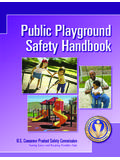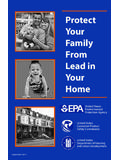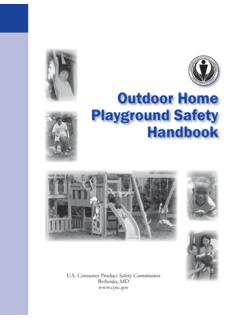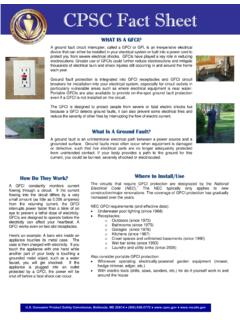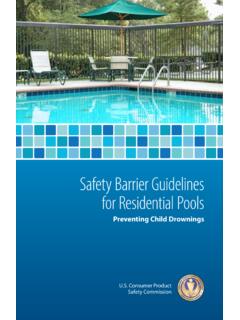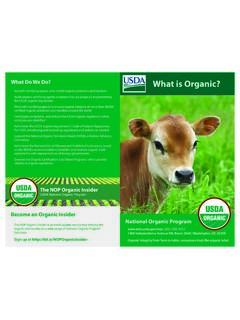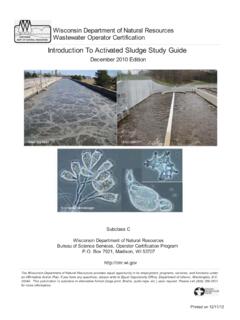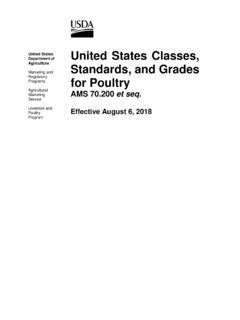Transcription of A Guide to United States Furniture Compliance ... - CPSC.gov
1 A Guide to United States Furniture Compliance Requirements Lisa M. Benson Karen Reczek This publication is available free of charge from: NISTIR 8119 NISTIR 8119 A Guide to United States Furniture Compliance Requirements Lisa M. Benson* Karen Reczek Standards Coordination Office * Dakota Consulting This publication is available free of charge from: February 2012 Revised March 2016 Department of Commerce Penny Pritzker, Secretary of Commerce National Institute of Standards and Technology Dr. Willie E. May, Director Acknowledgements The lead author for this document is Lisa M. Benson, Dakota Consulting, under contract to the Standards Coordination Office of NIST. Additional guidance, initial research, and review of the document were provided by the staff of the Standards Coordination Office of NIST including Mary Donaldson and Karen Reczek, and the Engineering Laboratory of NIST including, Richard G.
2 Gann. Invaluable support was also received from the knowledgeable experts at the Consumer product Safety Commission and the Federal Trade Commission who provided input into the document and also conducted a thorough review. Consumer product Safety Commission reviewers were Patty Edwards and Arlene Flecha Castro. Federal Trade Commission reviewers were Steve Ecklund and Robert Frisby. Table of Contents HOW TO USE THIS Guide .. 1 SCOPE .. 1 OVERVIEW OF FEDERAL REGULATORY FRAMEWORK .. 1 FEDERAL REGULATORY AUTHORITIES AND TECHNICAL REGULATIONS (MANDATORY) .. 2 Consumer product Safety Commission ( cpsc ) .. 2 Consumer product Safety Act (CPSA) .. 2 Consumer product Safety Improvement Act of 2008 (CPSIA) .. 2 Certificates and Mandatory Third-Party 2 Children s Furniture Items .. 3 Toddler Beds .. 3 Bassinets and 4 Full-Size Cribs and Non-Full-Size Cribs .. 4 Bedside Sleepers.
3 4 Bunk Beds .. 4 Tracking Labels for Children s Products .. 5 Federal Hazardous Substances Act (FHSA) .. 6 Sharp Points and Edges on Children s Products .. 6 Customs and Border Protection (CBP) .. 7 Country or Origin: Marking of Imported Articles and Containers .. 7 Environmental Protection Agency (EPA) .. 8 Antimicrobial Textiles: The Federal Insecticide, Fungicide, and Rodenticide Act (FIFRA) .. 8 Toxic Substances Control Act (TSCA) .. 8 Wood in Furniture : Formaldehyde in High Density Fiberboard (HDFB) .. 9 Federal Trade Commission (FTC) .. 10 Federal Trade Commission Act (FTC Act) .. 10 Used or Secondhand Stuffing Textile Fiber Products Identification Act .. 10 Environmental Marketing Claims .. 10 United States Department of Agriculture (USDA) .. 11 organic Fibers: organic Foods Production Act of 1990 (OFPA) .. 11 The Lacey Act .. 11 OVERVIEW OF STATE REGULATORY FRAMEWORKS .. 12 STATE REGULATORY AUTHORITIES AND TECHNICAL REGULATIONS (MANDATORY).
4 12 Packaging and Labeling .. 13 UPLR .. 13 Toxics in Packaging Legislation .. 13 Uniform Law Label .. 13 State of California .. 14 California Air Resources Board (CARB) - Formaldehyde Emissions .. 14 Lead and Other Toxic Substances .. 15 Upholstered Furniture Flammability Requirements .. 15 Safer Consumer Products Regulations .. 16 Made in the USA .. 16 State of 16 Lead .. 16 Minnesota .. 17 Formaldehyde in Children s Products .. 17 State of Washington .. 17 Lead, Cadmium, and Phthalates in Children s Products .. 17 Multiple States .. 18 Flame Retardant Regulations .. 18 Chemicals of 18 OVERVIEW OF THE VOLUNTARY STANDARDS FRAMEWORK .. 18 STANDARDS DEVELOPING ORGANIZATIONS (SDOS) .. 19 ASTM International .. 19 Business and Industrial Furniture Manufacturing Association (BIFMA International) .. 20 ANSI/BIFMA e3 Furniture Sustainability Standard .. 21 National Fire Protection Association (NFPA).
5 22 Upholstery Furniture Action Council (UFAC) .. 22 TESTING AND CERTIFICATION BODIES .. 23 Testing .. 23 23 California Air Resources Board (CARB) Third-Party Certification Program .. 23 Consumer Products Subject to a product Safety Rule .. 23 BIFMA Sustainability Certification Level .. 24 Juvenile Products Manufacturers Association (JPMA).. 24 RELEVANT GOVERNMENT AGENCIES .. 25 Customs and Border Protection (CBP) .. 25 Consumer product Safety Commission ( cpsc ) .. 25 Environmental Protection Agency (EPA) .. 25 Federal Trade 25 Department of Agriculture .. 25 Furniture INDUSTRY AND MARKET DATA .. 26 Trade Associations .. 26 American Home Furnishings Alliance .. 26 Upholstered Furniture Action Council .. 26 Furniture Market Data .. 26 Page | 1 A Guide to United States Furniture Compliance Requirements SCOPE This Guide addresses children s Furniture , upholstered Furniture and other types of Furniture .
6 This document does NOT address mattresses or other home furnishings such as carpets and rugs. OVERVIEW OF FEDERAL REGULATORY FRAMEWORK Once a law has been enacted by Congress, the appropriate federal agency ( , the Consumer product Safety Commission, the Federal Trade Commission, the National Highway Traffic and Safety Administration, et al.) may create the regulations to implement the law. Before such regulations can be adopted, the appropriate federal agency ordinarily will issue a notice of proposed rulemaking (NOPR) to solicit public comments on the proposed rules. To provide opportunity for public comment, the appropriate federal agency must issue draft regulations or Proposed Rules that are published in the Federal Register and as a WTO TBT notification. The agency reviews the comments and can then issue a Final Rule that also is published in the Federal Register, and later, published annually in the Code of Federal Regulations (CFR).
7 Together, the enabling acts/laws [published in the United States Code (USC) once passed] and the final regulations (published in the Code of Federal Regulations) provide a framework for the implementation and enforcement of most federal laws in the United States . HOW TO USE THIS Guide Regulations are mandatory Standards are voluntary (unless Incorporated by Reference in a regulation) Guidelines may be voluntary (but are often de facto industry standards) Red text highlights mandatory requirements Blue text indicates a hyperlink to a website, page or document on the web Page | 2 FEDERAL REGULATORY AUTHORITIES AND TECHNICAL REGULATIONS (MANDATORY) Several federal agencies administer regulations associated with Furniture . Agency Scope Consumer product Safety Commission ( cpsc ) Flammability of upholstered Furniture (proposed); lead containing surface coatings; children s Furniture Customs and Border Protection (CBP) Country of origin for most imported products Environmental Protection Agency (EPA) Formaldehyde in wood Federal Trade Commission (FTC) Labeling United States Department of Agriculture (USDA) organic claims Consumer product Safety Commission ( cpsc ) Consumer product Safety Act (CPSA) Title 15, United States Code, Chapter 47, Sections 2051-2089 The Consumer product Safety Act, entered into law on October 27, 1972, was enacted to establish the Consumer product Safety Commission and define its authority with the purpose of protecting the public against unreasonable risks of injury associated with consumer products.
8 Assisting consumers in evaluating the comparative safety of consumer products, developing uniform safety standards for consumer products; and promoting research and investigation into the causes and prevention of product -related deaths, illnesses, and injuries. Consumer product Safety Improvement Act of 2008 (CPSIA) Public Law 110 314, August 14, 2008 On August 14, 2008, President Obama signed into law Public Law 110-314 (Consumer product Safety Improvement Act of 2008). On August 12, 2011, he signed into law amendments to the Act, Public Law 112 28, August 12, 2011. The Act provided cpsc with significant new regulatory and enforcement tools as part of amending and enhancing several cpsc statutes, including the Consumer product Safety Act. Certificates and Mandatory Third-Party Testing Section 102 of the CPSIA requires every manufacturer or importer of all consumer products that are subject to a consumer product safety rule enforced by the cpsc to issue a general certificate of conformity based on testing of the product and stating that the product complies with the applicable standard, regulation, or ban.
9 The certificate must accompany the product and be furnished to the retailer or distributor. Section 102 also requires the manufacturers or importers of children s products (products designed and intended primarily for children age Page | 3 12 years or younger) to certify that the products comply with all relevant product safety standards by issuing a children s product certificate supported by tests performed by a cpsc -accepted third-party testing laboratory that has been accredited. cpsc also has regulations pertaining to certificates of Compliance ; they can be found at 16 CFR 1110. Rules for Furniture products that require third party testing and children s certificate include: 15 USC 1278a: Lead in Children's Products 16 CFR 1217, Safety Standard for Toddler Beds 16 CFR 1218, Safety Standard for Bassinets and Cradles 16 CFR 1219, Safety Standard for Full-Size Cribs 16 CFR 1220, Safety Standard for Non-Full-Size Cribs 16 CFR 1222, Safety Standard for Bedside Sleepers 16 CFR 1513, Requirements for Bunk Beds For more detailed information, see cpsc s: Detention of Products at Import (updated June 30, 2010) and Certificate of Conformity Children s Furniture Items The Consumer product Safety Commission ( cpsc ) regulates lead in consumer goods, especially children s products.
10 The Consumer product Safety Improvement Act of 2008 (CPSIA) establishes new lead content limits for children s products (for most children s products the limit is 100 parts per million (ppm)) and a lower lead limit for paint and surface coatings on Furniture and children s products. 16 CFR 1303, Lead in Paint on Certain Furniture Articles (Children s Furniture ) The Consumer product Safety Commission declares that paint and similar surface-coating materials for consumer use that contain lead or lead compounds and in which the lead content (calculated as lead metal) is in excess of percent (90 ppm) of the weight of the total nonvolatile content of the paint or the weight of the dried paint film (such paint and similar surface-coating materials are referred to hereafter as lead-containing paint ) are banned hazardous products under Sections 8 and 9 of the Consumer product Safety Act (CPSA), 15 USC 2057 and 2058.

